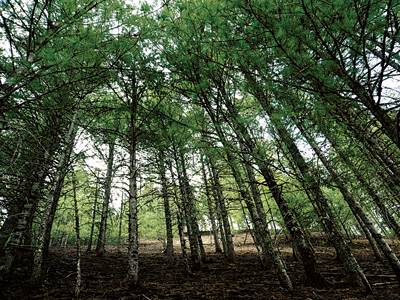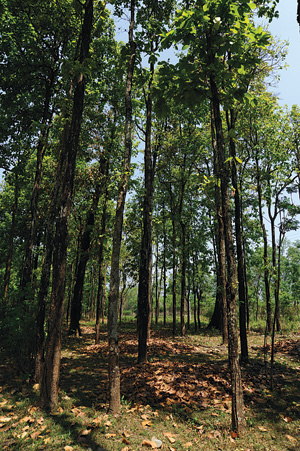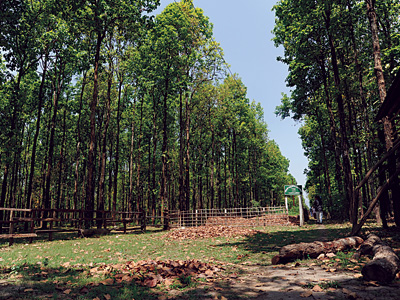Amulya's June 2012 ECS article on Sequoia and Sal

 In Nepal, Sal or Sakhuwa was the tree Maya Devi leaned upon to give birth to Buddha on the way to her maternal home in Tilaurakot. So was born the Kshatriya royal lineage of the Shakya, after the etymological root of the tree Sakhuwa, in whose kingdom they ruled until internecine royal warfare drove them to flee to the mountainous refuges of Kathmandu Valley.
In Nepal, Sal or Sakhuwa was the tree Maya Devi leaned upon to give birth to Buddha on the way to her maternal home in Tilaurakot. So was born the Kshatriya royal lineage of the Shakya, after the etymological root of the tree Sakhuwa, in whose kingdom they ruled until internecine royal warfare drove them to flee to the mountainous refuges of Kathmandu Valley.
 More than the valiant buffoonery of Jung Bahadur is the role of Nepal Sal in consolidating the British Empire in India. From the early twentieth century, the British dispatched Collier and Smythies to scout for Sal extraction routes along the rivers draining out of Nepal Terai and to covet the Rana government of the hard, big cash value of large-scale Sal export. The Ranas readily bought this idea, railheads were established in river outlets to India, and one of these, the Collier’s railhead, can still be witnessed today in Bardia National Park. Sal was felled in massive quantities, hauled by bullock carts, dumped to the rivers and floated to booms to flatter terrain railheads from where these logs were transported to British India with the highest concentration of people and agricultural lands, the Oudh province or Uttar Pradesh and Bihar. The British built a network of rail line along much of the Nepal border primarily for the strategic purpose of whisking their artillery at short notice and dispatch time to quell any uprising before they gathered steam to overwhelm the ruling but fewer numbered colonialists. Richard Tucker, an environmental historian and some doctoral scholars have back calculated the deforestation by multiplying the volume of each rail sleeper and the mileage of rail line.
More than the valiant buffoonery of Jung Bahadur is the role of Nepal Sal in consolidating the British Empire in India. From the early twentieth century, the British dispatched Collier and Smythies to scout for Sal extraction routes along the rivers draining out of Nepal Terai and to covet the Rana government of the hard, big cash value of large-scale Sal export. The Ranas readily bought this idea, railheads were established in river outlets to India, and one of these, the Collier’s railhead, can still be witnessed today in Bardia National Park. Sal was felled in massive quantities, hauled by bullock carts, dumped to the rivers and floated to booms to flatter terrain railheads from where these logs were transported to British India with the highest concentration of people and agricultural lands, the Oudh province or Uttar Pradesh and Bihar. The British built a network of rail line along much of the Nepal border primarily for the strategic purpose of whisking their artillery at short notice and dispatch time to quell any uprising before they gathered steam to overwhelm the ruling but fewer numbered colonialists. Richard Tucker, an environmental historian and some doctoral scholars have back calculated the deforestation by multiplying the volume of each rail sleeper and the mileage of rail line.


Sequoia and Sal-A tale of two trees
| June 2012 | Text by : Amulya Ratna Tuladhar Photograph by : ECS Media |
What can we say of the most majestic trees, Sequoia of California and Sal of the Terai? Big, large, great, fantastic? The adjectives quit and run.
Se quoia, or the California Redwoods, is between 350 to 370 feet tall. This is three times the height of Sal, which is 120 to 150 feet tall, or this is one and half times the height of Dharahara, or 200 feet of Bhimsen’s folly in Sundhara and twice the tallest statue of Shiva at Sanga Bhanjyang at 143 feet!
quoia, or the California Redwoods, is between 350 to 370 feet tall. This is three times the height of Sal, which is 120 to 150 feet tall, or this is one and half times the height of Dharahara, or 200 feet of Bhimsen’s folly in Sundhara and twice the tallest statue of Shiva at Sanga Bhanjyang at 143 feet!
 quoia, or the California Redwoods, is between 350 to 370 feet tall. This is three times the height of Sal, which is 120 to 150 feet tall, or this is one and half times the height of Dharahara, or 200 feet of Bhimsen’s folly in Sundhara and twice the tallest statue of Shiva at Sanga Bhanjyang at 143 feet!
quoia, or the California Redwoods, is between 350 to 370 feet tall. This is three times the height of Sal, which is 120 to 150 feet tall, or this is one and half times the height of Dharahara, or 200 feet of Bhimsen’s folly in Sundhara and twice the tallest statue of Shiva at Sanga Bhanjyang at 143 feet!
One would wonders, as in the case of a giraffe that, this means a lot of pressure to pump blood fifteen feet up to a giraffe’s head. How does the Sequoia send water 300 feet vertically up? A one-horse power 1500-kilowatt pump can barely pump 60 feet or seven stories up to our roofs, how do the trees manage?
When I was a graduate student at Virginia Tech, I used to measure the ‘blood pressure’ of White Pine for my thesis. Just before dawn at four, I would drive my 6-cylinder Chevrolet truck to the open cast coalmines of the Appalachian mountain bordering West Virginia. There I would excise the branches of the selected 8-year old pines and insert them into an air tight container and slowly squeeze the leaves with calibrated nitrogen gas pressure just like a doctor slowly releases pressure from the sphygmomanometer to measure our systolic and diastolic pressures.
The pressure at which sap would ooze out of the cut branch would be the water stress or negative pressure of the pine. In our vernacular, this is the measure of thirst or ‘suction pressure’ with which pines suck water from the roots to the tops of trees and foliage. Sequoias can suck up huge volumes of water and nutrients from deep loamy soils at valley bottoms to the tops of trees, 100 feet for Sal and 350 feet for Sequoia. In one year, a California Redwood can add one millimeter of growth to its cambium or living cylinder of tissue three hundred and fifty feet tall and fifty feet in girth, adding up to a ton of live wood growth per year and can constitute thirty seven thousand cubic feet growth of volume for a single tree.
Our Sal used to be among the tallest and largest trees of Terai. Quoting from an 1874 publication of Sir Dietrich Brandis, the father of Indian forestry imported from centuries of scientific forestry in Germany to manage British India forests, J. S. Gamble wrote in 1899 that, the “Nepal Terai has Sal, 100-150 feet tall with girth 20-25 feet and first branches at 60-80 feet.” By 1909 however, Upendranath Kanjilal in Forest Flora of the United Provinces of Agra and Oudh noted that Sal seldom attained more than 80 feet height and 6 feet girth. In my 30 years as forester of Nepal, I have yet to see a Brandis dimension Sal in Nepal, not even in the inner recesses of the protected areas of Chitwan in Kasra and the ravines of the Siwaliks, which I scoured for evidence of radio-collared tigers while working for the Smithsonian Tiger Ecology Project in 1978.
Where have all these majestic trees gone? Sequoia, which are old, old trees, two to three thousand years old, date back to the time of Siddharth Gautam, the Buddha of Kapil Vastu, even before the birth of Christ. Some of the Nepalese oaks are 400 years old and have recorded in their tree rings, the global effects of pollution emanating from the Industrial Revolution of Europe since 1700. Sal can be 150 to 200 years old, enough to have seen Jung Bahadur Rana romp around elephant hunting in Karrah Khola of Hetauda for fun and reprieve from the perennial conspirators who were out to kill him in Diamond Shumsher Rana’s ‘Seto Bagh’.
The sequoia that reigned supreme knew of the Red Indian natives that crossed the Bering Straits in the Aleutians from Asia to America, centuries before white man Columbus bungled into West Indies, later named America, in 1492. Several centuries later, the Gold Rush arrived that brought the white cowboys and prospectors streaming from the East Coast to California, the West Coast, and so began the demise of Sequoia.
 In Nepal, Sal or Sakhuwa was the tree Maya Devi leaned upon to give birth to Buddha on the way to her maternal home in Tilaurakot. So was born the Kshatriya royal lineage of the Shakya, after the etymological root of the tree Sakhuwa, in whose kingdom they ruled until internecine royal warfare drove them to flee to the mountainous refuges of Kathmandu Valley.
In Nepal, Sal or Sakhuwa was the tree Maya Devi leaned upon to give birth to Buddha on the way to her maternal home in Tilaurakot. So was born the Kshatriya royal lineage of the Shakya, after the etymological root of the tree Sakhuwa, in whose kingdom they ruled until internecine royal warfare drove them to flee to the mountainous refuges of Kathmandu Valley.
“In the 1840s, when American settlers arrived in Northern California, the redwood forest amounted to 2 million acres of virgin old-growth trees. Loggers began cutting the trees with axes or handsaws to make houses, barns and railroad ties. By 1920-30s, the introduction of logging machinery, chainsaws and Caterpillar tractors increase the speed of logging and old growth redwood forests began to disappear. Most forest became owned by timber companies which carried out clearfelling, and now with 96% of redwood forest gone, only about 90,000 acres remain in patches of protected land,” lamented a Sequoia tree climber in The New Yorker in 2011.
In Nepal, the secretive 8-mile thicket or Charkoshe Jhadi with malaria and tigers were an effective defense against enemies except for brief periods in winter and for the autochthonous Tharu tribals who had genetic immunity against malaria. But, after the 1816 debacle, when forests no longer served as effective bulwarks against the modern artillery and the more insidious ideas of modernization, the Sal forest started to assume economic importance for the British. After the 1857 Indian Sepoy Mutiny, the handful of British officers, their artillery and their mercenary local soldiers realized that they were too ill equipped to handle simultaneous insurrections over multiple Indian cities. Had it not been for Jung Bahadur galloping in uninvited to tame the Nawabs of Oudh, British Rule of India might have collapsed. So the Ranas were rewarded with a tract of Nepal Terai west of Butwal, the Naya Muluk, as a token of the eternal gratitude from the British.
 More than the valiant buffoonery of Jung Bahadur is the role of Nepal Sal in consolidating the British Empire in India. From the early twentieth century, the British dispatched Collier and Smythies to scout for Sal extraction routes along the rivers draining out of Nepal Terai and to covet the Rana government of the hard, big cash value of large-scale Sal export. The Ranas readily bought this idea, railheads were established in river outlets to India, and one of these, the Collier’s railhead, can still be witnessed today in Bardia National Park. Sal was felled in massive quantities, hauled by bullock carts, dumped to the rivers and floated to booms to flatter terrain railheads from where these logs were transported to British India with the highest concentration of people and agricultural lands, the Oudh province or Uttar Pradesh and Bihar. The British built a network of rail line along much of the Nepal border primarily for the strategic purpose of whisking their artillery at short notice and dispatch time to quell any uprising before they gathered steam to overwhelm the ruling but fewer numbered colonialists. Richard Tucker, an environmental historian and some doctoral scholars have back calculated the deforestation by multiplying the volume of each rail sleeper and the mileage of rail line.
More than the valiant buffoonery of Jung Bahadur is the role of Nepal Sal in consolidating the British Empire in India. From the early twentieth century, the British dispatched Collier and Smythies to scout for Sal extraction routes along the rivers draining out of Nepal Terai and to covet the Rana government of the hard, big cash value of large-scale Sal export. The Ranas readily bought this idea, railheads were established in river outlets to India, and one of these, the Collier’s railhead, can still be witnessed today in Bardia National Park. Sal was felled in massive quantities, hauled by bullock carts, dumped to the rivers and floated to booms to flatter terrain railheads from where these logs were transported to British India with the highest concentration of people and agricultural lands, the Oudh province or Uttar Pradesh and Bihar. The British built a network of rail line along much of the Nepal border primarily for the strategic purpose of whisking their artillery at short notice and dispatch time to quell any uprising before they gathered steam to overwhelm the ruling but fewer numbered colonialists. Richard Tucker, an environmental historian and some doctoral scholars have back calculated the deforestation by multiplying the volume of each rail sleeper and the mileage of rail line.
What appeared as a strategic tool to suppress insurrections served as a disaster relief adaptation for rushing in food supplies in times of frequent famines. Kingsley Davis, a demographer, has documented the steady rise in the population of India following the large-scale reduction in mortality after the railroads, contrary to all the bad things we say about the British. In Nepal too, despite the bad things we say about the Rana lust for power and the shameful palace shenanigans of the Shah kings then, the increased overall national stability and relief from frequent wars, overall increase in food production from new technology foods such as maize and potato translated into steady - though slow by current standards - rise in the population of Nepal, from 3 million when Prithvi Narayan Shah took over to 5 million by the time Rana left office in 1950, 200 years later. “Tera santan le danda kanda dhakun” or ‘May your posterity populate the hills and vales of Nepal’: the exhortation of P.N. Shah had come true. ■

CONTACT US | Location Map |
| Kupondole, Nepal Tel: 977 1 5011571 | Letters to the Editor Letters to the Online Editor Subscribe Now Advertise with us |
 | |
| Find us on google map | |
Advertisement






















